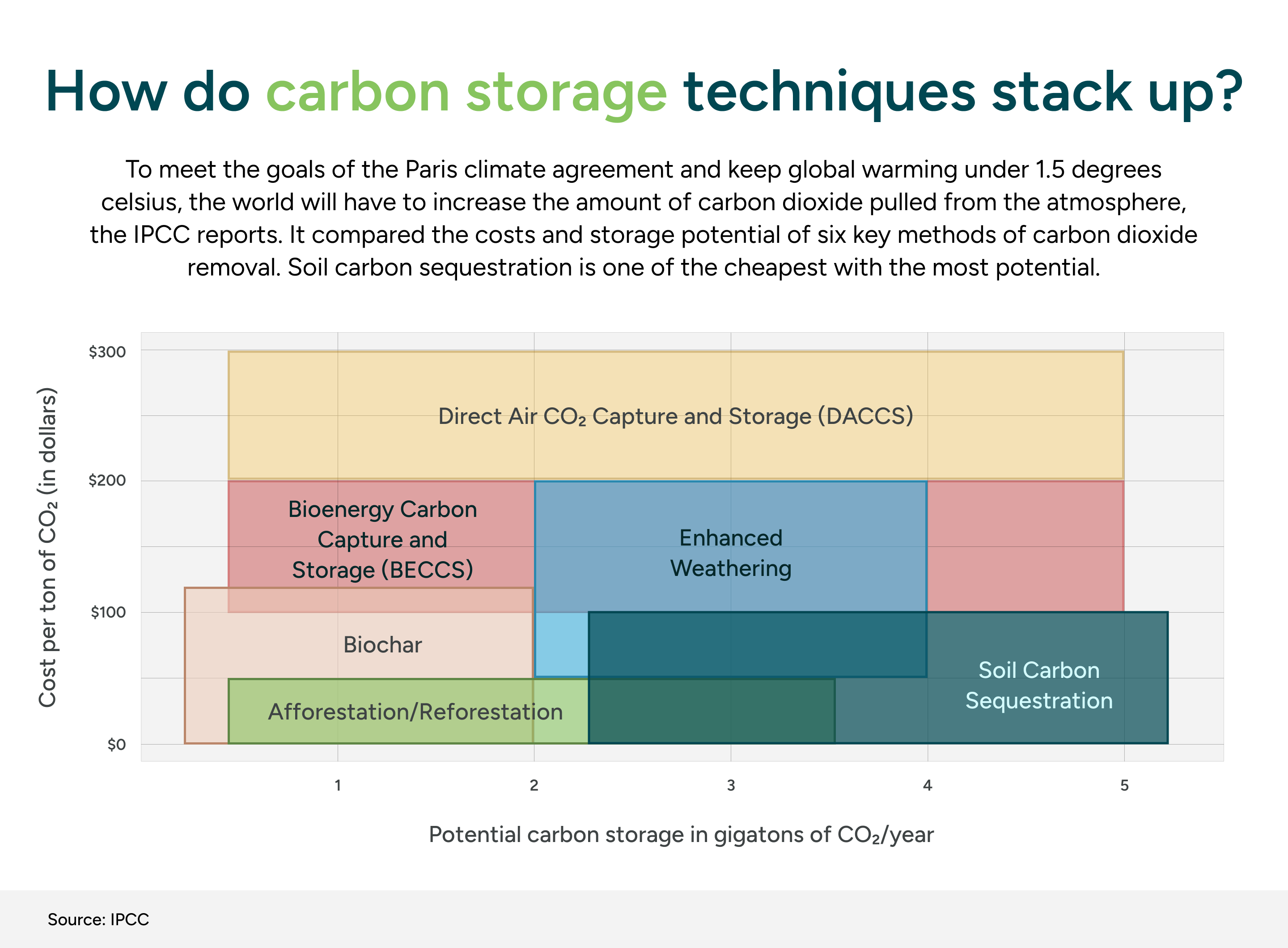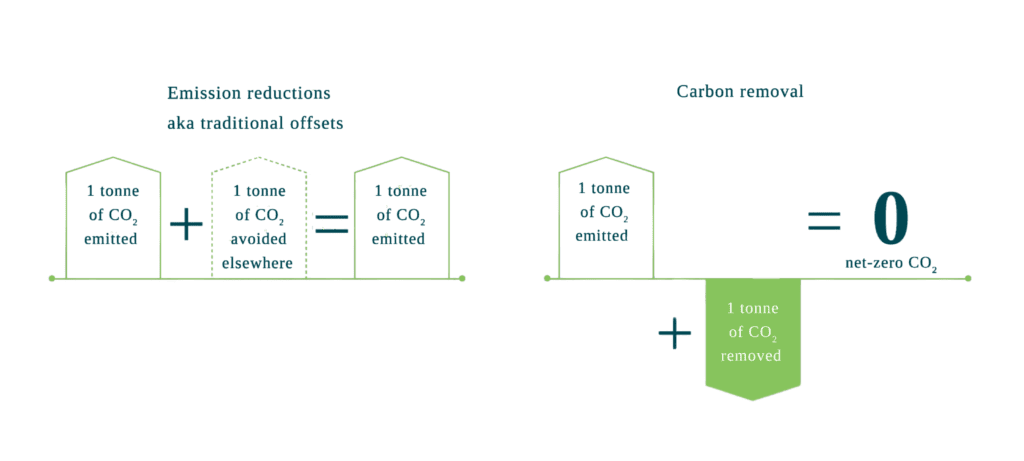desplazamiento

In the evolving landscape of the voluntary carbon market, discerning corporate buyers seek efficient carbon removal solutions with multifaceted environmental benefits. Soil carbon credits emerge as a standout choice for organizations dedicated to comprehensive environmental responsibility, providing an effective, low-risk pathway to achieving corporate climate targets. Below, we outline six reasons for your organization to offset emissions with premium soil carbon removal credits today.
Enhancing soil carbon sequestration through improved land management is one of the most affordable and readily deployable methods for sequestering carbon. It utilizes the natural process of photosynthesis, enhanced through regenerative agriculture, to draw carbon into the soil. This approach is both scalable and accessible, making it a practical solution for global carbon removal efforts.
Agricultural soils harbor the potential to remove 10% of global emissions each year. Boomitra’s digital tools for farmers and ranchers support them to optimize agricultural practices for increased carbon sequestration, without the need for costly interventions or hardware. Soil carbon credits are distinguished by their cost efficiency and carbon removal potential while offering vast co-benefits for people and the planet.

Corporations stand to reap financial benefits from investing in high-quality soil carbon credits due to the anticipated growth in the value of these assets. As market demand increases for carbon removal and regulations around carbon emissions become stricter, the value of carbon credits is expected to rise. Additionally, buying soil carbon credits can open new market access opportunities, aligning businesses with emerging trends in sustainability.
Moreover, these credits can serve as conversion credits in cap-and-trade systems, allowing businesses to offset their carbon footprint. Government mandates around carbon neutrality are becoming more prevalent and purchasing soil carbon credits now would position corporations ahead of these regulatory changes, reducing future compliance costs.
Boomitra soil carbon projects catalyze community development. Our portfolio of projects spans the global south, from South America to Africa to India, where the impacts of climate change are most acutely felt. Each project boosts agricultural productivity, food security, and economic resilience through building healthy, carbon-rich soils. These carbon-rich soils support more reliable crop yields in the face of climate variability. “We cannot feed people if soil is degraded,” said Rattan Lal, Director of Ohio State University’s Carbon Management and Sequestration Center.
In addition to a new revenue stream from the sale of carbon credits, farmers increase their income due to the associated increase in crop yields. Our soil carbon projects therefore facilitate a positive feedback loop that benefits both the community and the environment.
By investing in soil carbon initiatives, you are investing in people. Farmers and ranchers are the custodians of the land, and by providing them with the support and resources necessary to adopt regenerative practices, we enable them to cultivate sustainable livelihoods. Purchasing soil carbon credits enhances your corporate social responsibility (CSR) profile, aligning your operations with a vision of global ecological and community health.
By investing in soil carbon initiatives, you are investing in people.
Soil carbon is pivotal in ecosystem restoration and biodiversity conservation. Our projects employ regenerative agricultural practices — such as cover cropping, no-till farming, and rotational grazing — which not only boost soil carbon but also foster a thriving habitat for diverse soil microorganisms. These microorganisms enhance soil structure and fertility, aiding plant health and growth through improved nutrient absorption and pathogen protection.
Above ground, these regenerative practices transform farms into habitats rich in biodiversity. They draw pollinators like bees and butterflies that improve crop yields and quality. Beneficial insects like beetles and spiders naturally control pests. Farmers and ranchers become less dependent on chemical pesticides. Birds contribute to this balanced ecosystem by managing pests and dispersing seeds. Where there are birds, there is plant diversity.
This biodiversity underpins agricultural resilience, equipping farming systems to better adapt to climate change. It promotes sustainable productivity and is essential for the environmental health, efficiency, and stability of food production systems.
“From just one species of grass now we have 17 species of grass,” Jorge, a participating rancher in Northern Mexico, observed. “In addition to increased grass biodiversity, there are more species of birds and other small animals for coyotes and pumas to prey on, which has ultimately reduced predation of our livestock.”
Boomitra collaborates with local agricultural organizations to empower farmers and ranchers in adapting to and mitigating climate change. These land stewards are provided with tailored strategies to mitigate risks associated with pests, diseases, or extreme weather. For example, participating farmers prevent erosion by reducing tillage and planting cover crops. Ranchers increase drought resilience by adopting practices that improve soil cover and developing advanced water storage systems.
Furthermore, by adopting regenerative agricultural practices, farmers and ranchers significantly contribute to climate change mitigation via enhanced soil carbon sequestration. To date, Boomitra’s network of farmers and ranchers has sequestered 10 million tonnes of CO2 equivalent from the atmosphere. These methods bolster the resilience of agricultural ecosystems, paving the way for a more robust and stable agricultural sector.
Not all carbon credits are created equal. With traditional carbon offsets, emitted carbon remains in the atmosphere. Carbon removal credits, which draw down carbon from the atmosphere, are the only way to truly offset emissions and move towards net zero. Your purchase of Boomitra premium soil carbon removal credits has an immediate impact – each credit represents a tonne of CO2 that would otherwise have remained in the atmosphere.

By purchasing premium soil carbon credits from Boomitra’s project portfolio, your organization can actively strengthen its CSR footprint and tap into emerging markets, while playing a pivotal role in climate change mitigation, community development, and biodiversity enhancement. It’s a strategic investment that goes beyond financial returns, offering a meaningful contribution to a more sustainable and resilient future.
Ready to take the next step? Talk to our team to learn more.



